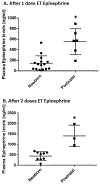Bioavailability of endotracheal epinephrine in an ovine model of neonatal resuscitation
- PMID: 30660015
- PMCID: PMC6402978
- DOI: 10.1016/j.earlhumdev.2019.01.006
Bioavailability of endotracheal epinephrine in an ovine model of neonatal resuscitation
Abstract
Background: Distressed infants in the delivery room and those that have completed postnatal transition are both resuscitated according to established neonatal resuscitation guidelines, often with endotracheal (ET) epinephrine at the same dose. We hypothesized that ET epinephrine would have higher bioavailability in a post-transitional compared to transitioning newborn model due to absence of fetal lung liquid and intra-cardiac shunts.
Methods: 15 term fetal (transitioning newborn) and 6 postnatal lambs were asphyxiated by umbilical cord and ET tube occlusion respectively. Lambs were resuscitated after 5 min of asystole. ET epinephrine (0.1 mg/kg) was administered after 1 min of positive pressure ventilation (PPV) and chest compressions, and repeated 3 min later, followed by intravenous (IV) epinephrine (0.03 mg/kg) every 3 min until return of spontaneous circulation (ROSC). Serial plasma epinephrine concentrations were measured.
Results: Peak plasma epinephrine concentrations were lower in transitioning newborns as compared to postnatal lambs: after a single ET dose (145.36 ± 135.5 ng/ml vs 553.54 ± 215 ng/ml, p < 0.01) and after two ET doses (443 ± 192.49 ng/ml vs 1406 ± 420.8 ng/ml, p < 0.01). The rates of ROSC with a single ET dose were similar in both groups (40% vs 50% in newborn and postnatal respectively, p > 0.99). There was a higher incidence of post-ROSC tachycardia and increased carotid blood flow in the postnatal group.
Conclusions: In the postnatal period, ET epinephrine at currently recommended doses resulted in higher peak epinephrine concentrations, post-ROSC tachycardia and cerebral reperfusion without significant differences in incidence of ROSC. Further studies evaluating the optimal dose of ET epinephrine during the postnatal period are warranted.
Keywords: Endotracheal epinephrine; Epinephrine concentration; Lung liquid; Neonatal resuscitation.
Copyright © 2019 Elsevier B.V. All rights reserved.
Figures


 Postnatal group (n=3). * p<0.01 vs newborn by Mann Whitney U test
Postnatal group (n=3). * p<0.01 vs newborn by Mann Whitney U test
 Postnatal group (n=6) ▴ Historical newborn lambs receiving only IV epinephrine (dose, 0.03 mg/kg - n=8)
Postnatal group (n=6) ▴ Historical newborn lambs receiving only IV epinephrine (dose, 0.03 mg/kg - n=8)
 ET Postnatal group (n=3)▴ Historical newborn lambs receiving only IV epinephrine (n=8). The vertical grey bar depicts time of ROSC.
ET Postnatal group (n=3)▴ Historical newborn lambs receiving only IV epinephrine (n=8). The vertical grey bar depicts time of ROSC.
 Postnatal group (n=5) * p<0.01 by Mann Whitney U test vs newborn at the same time point.
Postnatal group (n=5) * p<0.01 by Mann Whitney U test vs newborn at the same time point.References
-
- Textbook of Neonatal Resuscitation (NRP), 7th Ed. Weiner GM, Zaichkin J, editors2016. 326 p.
-
- Wyckoff MH, Aziz K, Escobedo MB, Kapadia VS, Kattwinkel J, Perlman JM, et al. Part 13: Neonatal Resuscitation: 2015 American Heart Association Guidelines Update for Cardiopulmonary Resuscitation and Emergency Cardiovascular Care. Circulation. 2015;132(18 Suppl 2):S543–60. - PubMed
-
- Weiner GM, Niermeyer S. Medications in neonatal resuscitation: epinephrine and the search for better alternative strategies. Clinics in perinatology. 2012;39(4):843–55. - PubMed
-
- Kleinman ME, Oh W, Stonestreet BS. Comparison of intravenous and endotracheal epinephrine during cardiopulmonary resuscitation in newborn piglets. Crit Care Med. 1999;27(12):2748–54. - PubMed

